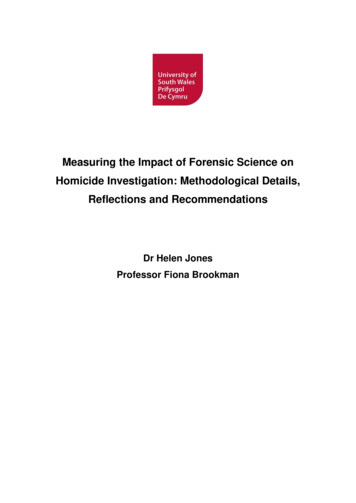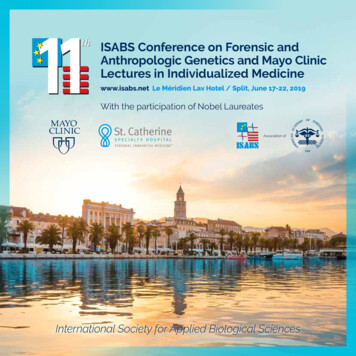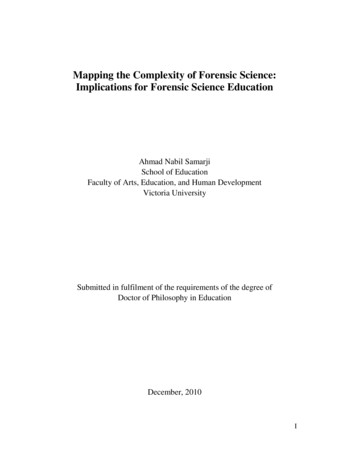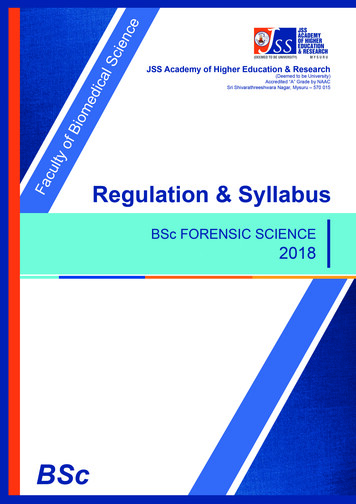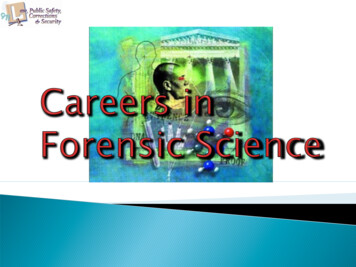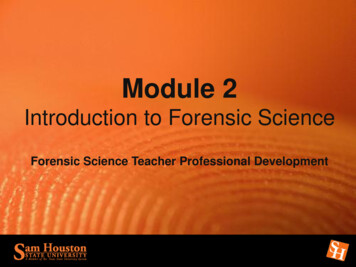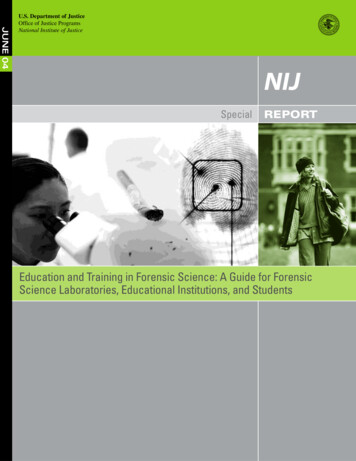
Transcription
JUNE 04U.S. Department of JusticeOffice of Justice ProgramsNational Institute of JusticeSpecialREPORTEducation and Training in Forensic Science: A Guide for ForensicScience Laboratories, Educational Institutions, and Students
U.S. Department of JusticeOffice of Justice Programs810 Seventh Street N.W.Washington, DC 20531John AshcroftAttorney GeneralDeborah J. DanielsAssistant Attorney GeneralSarah V. HartDirector, National Institute of JusticeThis and other publications and products of the National Instituteof Justice can be found at:National Institute of Justicewww.ojp.usdoj.gov/nijOffice of Justice ProgramsPartnerships for Safer Communitieswww.ojp.usdoj.gov
JUNE 04Education and Training inForensic ScienceA Guide for Forensic Science Laboratories,Educational Institutions, and StudentsDeveloped and Approved by the Technical Working Group forEducation and Training in Forensic ScienceNCJ 203099
Sarah V. HartDirectorFindings and conclusions of the research reported here are those of the authors and do notreflect the official position or policies of the U.S. Department of Justice.The National Institute of Justice is a component of the Office of Justice Programs, which alsoincludes the Bureau of Justice Assistance, the Bureau of Justice Statistics, the Office of JuvenileJustice and Delinquency Prevention, and the Office for Victims of Crime.
Message From the DirectorForensic scientists play a pivotal role in thecriminal justice system, providing crucialinformation about the evidence to the trierof fact. Because the work they do bothat the crime scene and in the laboratoryoften must be used in court, it is especial ly important that the training and educa tion of forensic scientists provide a solidscientific background and a broad base incriminalistics.Interest in forensic science has increaseddramatically in the past 10 years. Inresponse to this interest, many universi ties have begun to offer degrees in foren sic science at both the undergraduate andgraduate level. To ensure that these pro grams adequately prepare practitionersfor their careers in operational laboratories,the U.S. Department of Justice (DOJ) hassupported West Virginia University’s estab lishment of the Technical Working Groupfor Education and Training in ForensicScience for the purpose of recommendingbest practices for educational curriculumsin forensic science. These recommenda tions encompass the current best practicesand procedures for initial and continuingtraining models to provide those seeking tobecome forensic scientists with the educa tional and practical knowledge and skillsnecessary to effectively support their rolein the criminal justice system.This publication is especially timely asPresident Bush has directed DOJ toundertake a 1 billion, 5-year program toimprove the Nation’s capacity to use DNAevidence as a routine law enforcement tool.This capacity-building plan seeks to improveall aspects of the system—evidence collec tion, presentation, analysis, and use incourt. Ensuring that this Nation has anadequate pool of trained forensic scien tists is critical to achieving this goal.I commend the hard work of the mem bers of the Technical Working Group thatcreated this consensus document. Theyare representative of forensic science edu cators, laboratory directors, forensic sci ence trainers, education professionals,prosecutors, and defense attorneys. Theircollective expert knowledge, experience,and dedication to the task made this efforta success.Educational programs and training modelswill vary based on the needs of the particu lar organization and jurisdiction in whichthey are implemented. The criteria set forthin this document can serve as a guide foruniversities to promote quality educationand training in forensic science disciplinesby promoting a consistent approach whiletailoring their programs to meet the needsof the applicable community.Sarah V. HartDirector,National Institute of Justiceiii
Technical Working Group on Education andTraining in Forensic ScienceThe Technical Working Group on Educationand Training in Forensic Science (TWGED)is a multidisciplinary group of content areaexperts from across the United States andCanada, from both urban and rural jurisdic tions, each representing his or her respec tive agency or practice. Each individual isinvolved in educating and/or training foren sic scientists (as students or professionals).They represent academia, forensic sciencelaboratories, professional forensic scienceorganizations, and the legal system.At the outset of the effort to develop thisGuide, the National Institute of Justice(NIJ) created a planning panel—composedof forensic science educators, crime labo ratory directors, and trainers—to defineneeds, develop initial strategies, and steerthe larger group. This planning panel firstdetermined that an NIJ technical workinggroup would provide the best approachfor addressing the demonstrated needs.Additional members of the technical work ing group were then selected from recom mendations solicited from the planningpanel and national organizations, includ ing the American Academy of ForensicSciences, American Society of CrimeLaboratory Directors, American Societyof Crime Laboratory Directors/LaboratoryAccreditation Board, International Associa tion for Identification, Drug EnforcementAdministration, Federal Bureau of Investi gation, George Washington University,West Virginia University, Marshall Univer sity, and the National Forensic ScienceTechnology Center.During a 1-year period, the 47 membersand 2 designees of the TWGED listedbelow worked together to develop thisGuide:Education and Training inForensic SciencePlanning PanelDr. Jack BallantyneAssociate ProfessorDepartment of ChemistryUniversity of Central FloridaOrlando, FLInspector Mark DaleLaboratory DirectorNew York State PoliceAlbany, NYDr. Allison EastmanSupervisor of DNA ServicesNew York State PoliceAlbany, NYLinda ErrichettoLaboratory DirectorLas Vegas Metropolitan Police DepartmentForensic LaboratoryLas Vegas, NVDr. Terry FengerDirectorMarshall University Forensic ScienceCenterHuntington, WVBarry FisherDirectorScientific Services BureauLos Angeles County Sheriff’s OfficeLos Angeles, CADr. Jane HomeyerForensic Science Training Unit ChiefLaboratory DivisionFederal Bureau of InvestigationQuantico, VAv
Peter MaroneCentral Lab DirectorDivision of Forensic SciencesCommonwealth of VirginiaRichmond, VAGarry BombardDirector of TrainingIllinois State Police DepartmentForensic Sciences CommandChicago, ILDr. Carl SelavkaDirectorMassachusetts State Police CrimeLaboratorySudbury, MADr. Robert BrinerDirectorSoutheast Missouri Regional CrimeLaboratoryCape Girardeau, MODr. Ian TebbettEducation and Training ConsultantUniversity of FloridaGainesville, FLDr. Michael BourkeDNA ManagerConnecticut Department of Public SafetyMeriden, CT*Dr. Michael YuraDirectorForensic Identification ProgramWest Virginia UniversityMorgantown, WVDr. Yale CaplanDirectorNational Scientific ServicesBaltimore, MDAdditional TechnicalWorking Group MembersDr. José AlmirallDirectorForensic Science ProgramFlorida International UniversityMiami, FLKathleen BarchDeputy DirectorOhio Bureau of Criminal Identificationand InvestigationLondon, OHDr. Clifton BishopCurriculum Coordinator and AdvisorForensic Identification ProgramWest Virginia UniversityMorgantown, WVviElizabeth CarpenterLaboratory DirectorOregon State Police Crime LaboratoryPortland, ORAlan ClarkAssociate Deputy Assistant AdministratorOffice of Forensic SciencesDrug Enforcement Agency HeadquartersWashington, DCDr. Peter DeForestProfessor of CriminalisticsJohn Jay CollegeCity University of New YorkNew York, NYDr. Christopher D’EliaVice President for ResearchState University of New YorkAlbany, NYDr. Jamie DownsDirector/Chief Medical ExaminerAlabama Department of Forensic SciencesAuburn, AL
Dr. David ForanAssistant ProfessorGeorge Washington UniversityDepartment of Forensic SciencesWashington, DCDr. James FoxLipman Family Professor of CriminalJusticeCollege of Criminal JusticeNortheastern UniversityBoston, MADr. Robert FraasDirectorForensic Science ProgramEastern Kentucky UniversityRichmond, KYDr. Robert GaensslenDirector of Graduate StudiesForensic Science ProgramUniversity of Illinois at ChicagoChicago, ILDr. Howard HarrisDirectorForensic Science ProgramUniversity of New HavenWest Haven, CTDr. Neal HaskellForensic EntomologistSt. Joseph’s CollegeRensselaer, INCarol Henderson, J.D.Professor of LawShepard Broad Law CenterNova Southeastern UniversityFort Lauderdale, FLSusan JohnsBureau ChiefIllinois State PoliceSpringfield, ILDr. Graham JonesPresidentForensic Specialties Accreditation BoardMedical Examiner’s OfficeEdmonton, Alberta, CanadaDr. Karen KershensteinPresidentKWK EnterprisesFairfax Station, VAKevin LothridgeDeputy DirectorNational Forensic Science and TechnologyCenterLargo, FLJoseph PolskiChief Operations OfficerInternational Association for IdentificationMendota Heights, MNLawrence PresleyDirector of CriminalisticsNational Medical ServicesWillow Grove, PAVictor ReeveLaboratory DirectorCalifornia Criminalistics InstituteSacramento, CAGerald RichardsRichards Forensic ServicesLaurel, MDDwane HilderbrandScottsdale Crime LaboratoryScottsdale, AZDr. Kathy RobertsAssistant ProfessorCalifornia State UniversityLos Angeles, CAKaren IrishDirector of Forensic SciencesBaltimore County Police DepartmentTowson, MDLinda RourkeJohn Jay CollegeCity University of New YorkBayside, NY*vii
Dr. George SensabaughProfessor of Biomedical and ForensicSciencesUniversity of CaliforniaBerkeley, CADr. Charles TindallDirector of Forensic ScienceMetropolitan State College of DenverDenver, CODr. Victor WeednPrincipal Research Scientist and Directorof Biotechnology and Health InitiativesCarnegie Mellon UniversityPittsburgh, PADr. Jeffrey WellsAssociate ProfessorDepartment of Justice SciencesUniversity of Alabama at BirminghamBirmingham, ALviiiWayne Williams, J.D.Electronic Consultant/Attorney-at-LawHyattsville, MDAmy WongLaboratory DirectorVirginia Division of Forensic ScienceFairfax, VAKenneth ZercieAssistant DirectorConnecticut State Police ForensicLaboratoryMeriden, CT*Designee who attended one meeting asa proxy for a TWGED member.
AcknowledgmentsThe National Institute of Justice (NIJ) andWest Virginia University (WVU) wish tothank the members of the Technical Work ing Group on Education and Training inForensic Science (TWGED) for their exten sive efforts and dedication to the enhance ment of education and training in forensicscience. The TWGED members, who arenational experts representing academia,forensic science laboratories, professionalorganizations, and the legal system, gener ously gave their time to draft and reviewthis document. In addition, thanks areextended to the agencies and organiza tions that TWGED members representfor their flexibility and support, which en abled the participants to see this projectto completion.NIJ and WVU would like to thank all theindividuals from various national organiza tions who responded to the request fornominations of experts with a wideexpanse of knowledge and experiencefrom different areas of forensic science,both in practice and education. It was fromtheir recommendations that the memberswere selected. In particular, thanks toMary Fran Ernst from the AmericanAcademy of Forensic Sciences, Keith K.Coonrod from the American Society ofCrime Laboratory Directors, Robert S.Conley from the American Society ofCrime Laboratory Directors/LaboratoryAccreditation Board, Thomas C. Smithfrom the American Bar Association,Criminal Justice Section, Jennifer S.Mihalovich from the American Board ofCriminalistics, Thomas Janovsky from theDrug Enforcement Agency, Dick Johnsonfrom the National White Collar CrimeCenter, Dr. Michael Baer from the Ameri can Council on Education, Dr. Jay Siegelfrom Michigan State University, Dr. Ray H.Liu from the University of Alabama–Birmingham, Dr. David A. Rowley fromthe George Washington University, andDr. Philip H. Yeagle from the University ofNew Haven. NIJ, WVU, and TWGED alsowould like to thank the numerous individu als and organizations who were sent a draftof the Guide for review and comment.WVU would like to thank President DavidHardesty, Provost Gerry Lang, Vice Presi dent for Research John Weete, Director ofthe Forensic Identification Program MichaelYura, Forensic Identification ProgramAdministrative Assistant Lori Britton, andProjects Director Max M. Houck for theircommitment and dedication to the forensicsciences and this project.ix
About This ReportThe results of forensic investigations oftencan be the difference between acquittaland conviction in a court of law. The validi ty of those results depends on the knowl edge, skills, and experience of the forensicscientists working to obtain them. TheNational Institute of Justice, with supportfrom the West Virginia University, createdthe Technical Working Group for Educationand Training in Forensic Science (TWGED)to establish best practices for educatingand training forensic scientists. The work ing group developed the consensus crite ria and recommendations presented in thisreport. This information serves students asthey prepare for a career in forensic sci ence, educational institutions as theydevelop and revamp curriculums, andforensic scientists as they advance theirknowledge, skills, and abilities in theconstantly evolving forensic sciencedisciplines.coursework in specialized, forensic, andlaboratory sciences and other classesthat complement the student’s area ofconcentration.What does the workinggroup recommend?Forensic scientists have an ongoing obliga tion to advance their field through trainingand continuing professional development.Training programs should include writtencomponents (e.g., instructor qualifications,student requirements, performance goals,and competency testing), and their con tent should contain several core anddiscipline-specific elements guided bypeer-defined standards. Continuing profes sional development—mechanisms throughwhich forensic scientists remain current oradvance their expertise—should be struc tured, measurable, and documented.A solid educational background in naturalsciences with extensive laboratory course work establishes the groundwork for acareer in forensic science. Strong personalattributes, professional skills, certification,and professional involvement also are criti cal to the professional growth of prospec tive and practicing forensic scientists.Undergraduate degree. Undergraduateforensic science degree programs areexpected to deliver a strong and crediblescience foundation that emphasizes thescientific method and problem-solvingskills. Exemplary programs would beinterdisciplinary and include substantiallaboratory work, as most employmentopportunities occur in laboratory settings.Natural sciences should dominate under graduate curriculums and be supported byGraduate degree. Graduate programs canmove students from theoretical conceptsto discipline-specific knowledge. Exemplarycurriculums can include such topics ascrime scenes, physical evidence, law/science interface, ethics, and quality assur ance to complement the student’s ad vanced coursework. Graduate programsshould be designed with strong laboratoryand research components. Access toinstructional laboratories with researchspecific facilities, equipment, and instru mentation and interaction with forensiclaboratories are required to enhance thegraduate-level experience. By emphasizingwritten and oral communication and reportwriting, graduate programs can preparestudents for future courtroom testimony.Who should read this report?Forensic science laboratory managers in volved with hiring and training forensicscientists, educational institutions that offeror are seeking to establish forensic scienceprograms, and individuals beginning or con tinuing careers in forensic science.xi
ContentsMessage From the Director . . . . . . . . . . . . . . . . . . . . . . . . . . . . . . . . . . . . . . . . iiiTechnical Working Group on Education and Training in Forensic Science . . . . . . vAcknowledgments . . . . . . . . . . . . . . . . . . . . . . . . . . . . . . . . . . . . . . . . . . . . . . . ixAbout This Report . . . . . . . . . . . . . . . . . . . . . . . . . . . . . . . . . . . . . . . . . . . . . . . . xiIntroduction . . . . . . . . . . . . . . . . . . . . . . . . . . . . . . . . . . . . . . . . . . . . . . . . . . . . . 1Qualifications for a Career in Forensic Science . . . . . . . . . . . . . . . . . . . . . . . . . . 7Undergraduate Curriculum in Forensic Science. . . . . . . . . . . . . . . . . . . . . . . . . 11Graduate Curriculum in Forensic Science . . . . . . . . . . . . . . . . . . . . . . . . . . . . . 19Training and Continuing Education in Forensic Science . . . . . . . . . . . . . . . . . . 25Glossary . . . . . . . . . . . . . . . . . . . . . . . . . . . . . . . . . . . . . . . . . . . . . . . . . . . . . . 31Appendix A: Forensic Science Careers Outside the Traditional ForensicScience Crime Laboratory. . . . . . . . . . . . . . . . . . . . . . . . . . . . . . . . . . . . . . . . . 33Appendix B: Non-TWGED Reviewers . . . . . . . . . . . . . . . . . . . . . . . . . . . . . . . . 37Appendix C: Forensic Science Professional and Certification Organizations . . 41Appendix D: Technical and Scientific Working Groups. . . . . . . . . . . . . . . . . . . . 43Appendix E: Technical and Scientific Working Groups’ Educational Criteria . . . 45xiii
IntroductionForensic science plays a crucial role in thejustice system by providing scientific andfoundational information for investigationsand the courts.1 The Technical WorkingGroup on Education and Training in For ensic Science (TWGED) focused primarilyon education and training in those disci plines traditionally and generally associat ed with the work of forensic sciencelaboratories, commonly referred to as“criminalistics.” (For more informationon criminalistics, see “What Is ‘Criminal istics’?”) Criminalistics is the professionand scientific discipline directed towardthe recognition, identification, individualiza tion, and evaluation of physical evidence inlegal proceedings by the application of thenatural sciences. There are many otherforensic science specialty areas whoseeducational and training requirements aredistinctly different from the traditional lab oratory science areas, such as forensiccomputer science, forensic entomology,and forensic psychology; these are morefully described in appendix A.employees’ academic background, whichmay assist laboratories in posting and fill ing forensic science positions. The Guidealso provides structure for the continuingeducation of practicing forensic scientistsand training to enhance a current employee’s knowledge, skills, and abilities(KSAs).How to Use This GuideBackgroundThis Guide is intended for use by forensicscience laboratories in hiring and trainingforensic scientists, educational institutionsoffering or seeking to establish forensicscience programs, and individuals begin ning or continuing careers in forensicscience.As stated in NIJ’s 1999 publicationForensic Sciences: Review of Status andNeeds, the educational and training needs“of the forensic community are immense.Training of newcomers to the field, as wellas providing continuing education for sea soned professionals, is vital to ensuringthat crime laboratories deliver the bestpossible service to the criminal justicesystem. Forensic scientists must stay upto date as new technology, equipment,Forensic science laboratories can use thisGuide in a variety of ways. It offers sug gested qualifications for prospectiveEducational institutions can use this Guideto gauge the curriculum and structure oftheir forensic science academic programs.As a reflection of the forensic sciencecommunity’s needs and requirements,this Guide also may provide direction andideas for the design or expansion of theseprograms.In addition, prospective forensic sciencestudents can use this Guide to assist themin evaluating forensic science academicprograms. It can also provide guidanceregarding the requirements, career paths,and expectations for a career in forensicscience.1
SPECIAL REPORT / JUNE 04WHAT IS “CRIMINALISTICS”?“Criminalistics is the science and professiondealing with the recognition, collection, identifi cation, individualization, and interpretation ofphysical evidence, and the application of thenatural sciences to law-science matters. Theterm originated from the book Handbuch furUntersuchungsrichter als System derKriminalististik (3d ed., 1898) by Hans Gross, aninvestigating magistrate and professor of crimi nology at the University of Prague. He describedthe need for a scientifically trained investigatorwho could undertake certain technical aspectsof an investigation and could also serve as liai son between scientific specialists who mightassist in the investigation of criminal activity.This concept was popular in Europe, where anumber of forensic science institutes weredeveloped to apply the tools and techniques ofthe natural sciences to the investigation ofcrime and, generally, in official governmentalinquiries.”aThe following specialized areas may be includedunder the criminalistics umbrella: biology (in cluding biochemistry, molecular biology, andDNA analysis);b chemistry; toxicology; micro scopy; analysis of controlled substances, firedebris, explosive residues, hairs, fibers, glass,soil, paint and other materials, and fingerprintsand other impressions (such as footwear andtire tracks); questioned documents; toolmarkand firearms identification; and reconstructionand reconstruction patterns.Like other scientific and technical subjects,forensic science and criminalistics have special ized terminology that may not always be clear tononspecialists. In addition, professionals in thefield may not agree on the meaning of everyterm. To help make this document more accessi ble, some of the terms used to describe special ized areas of criminalistics are discussed here.In biological evidence analysis, the term “for ensic serology” was common for a long timebecause blood groups were among the individ ual features of blood and physiological fluids.2“Serology” is the study of blood groups (bloodtypes). In the 1970s, a number of proteins, someof which were enzymes, came into use as addi tional individual characteristics of blood andphysiological fluids, and the term “forensic bio chemistry” came into use. With the introductionof DNA typing in the mid-1980s, forensic scien tists no longer used blood types, enzymes, orother proteins to characterize biological evi dence. The term “forensic molecular biology”tries to capture forensic DNA analysis. “For ensic biology” usually now means the analysisof blood and physiological fluids, including DNAtyping. Some specialized areas such as analysisof botanical evidence also are part of “forensicbiology.”“Forensic chemistry” sometimes means the useof analytical chemical methods to analyze con trolled substances (illegal drugs). It also com monly encompasses the use of chemicalmethods to analyze fibers, glass, soil, paint, andother materials. These materials have oftenbeen called trace evidence in forensic science,but lately, some professionals have come to rec ognize that “trace” is a misleading term for thisclass of evidence. For one thing, it implies thatthere is a small quantity, which is not necessari ly true. Microscopy is commonly used to con duct these types of examinations.Fingerprint analysis includes automated finger print identification system (AFIS) technologies,methods for developing latent fingerprints, andfingerprint comparison and identification. Thelatter two areas are most often identified withcriminalistics.Toolmark and firearms identification refers tothe use of class and individual markings madeby tools or firearms to attribute markings to spe cific tools or bullets and/or cartridge cases tospecific weapons.Questioned documents, sometimes called“forensic document examination,” includes sev eral different types of examinations: comparing
EDUCATION AND TRAINING IN FORENSIC SCIENCEhandwriting with known handwriting samples todetermine whether or not a document was writ ten by a specific individual; examining machineprepared documents (e.g., typewriting) todetermine what type of machine or whether aspecific machine was used to prepare the docu ment; analysis of forgeries, counterfeit money, oridentification documents; and restoration of dam aged or altered documents.“Reconstruction” uses physical evidence and itsanalysis to help put together past events in timeand/or space. Reconstructions typically requiremethods, and techniques are developed.While training programs exist in a varietyof forms, there is a need to broaden theirscope and build on existing resources.”2Forensic Sciences: Review of Status andNeeds made a number of recommenda tions, including seeking mechanisms for— Accreditation/certification of forensicacademic training programs/institutions. Setting national consensus standards ofeducation in the forensic sciences. Establishing independent, communitywide, consensus standard-setting bod ies, such as Technical Working Groups. Funding by NIJ of forensic academicresearch and development programs. Ensuring that all forensic scientists haveprofessional orientations to the field,formal quality-assurance training, andexpert-witness training.In recent years, the demand for forensicscientists has increased for many reasons,including population demographics, in creased awareness of forensic scienceby law enforcement, increased numbersof law enforcement officers, databaseautomation in several categories ofthe documentation and analysis of patterns suchas bloodstain or glass fracture patterns. Recon struction as a part of criminalistics usuallyimplies not only studying patterns but also incor porating laboratory-based physical evidenceanalysis (and at times, analysis of the crimescene) into the final hypothesis.Notea. Barnett, P. “Criminalistics,” McGraw-Hill Encyclopedia ofScience & Technology, 9th ed. M. Licker (ed.). New York:McGraw-Hill, Inc., 2002.b. Words defined in the glossary are set in bold/italic type onfirst use to distinguish them from other text.physical evidence, jury expectations, legalrequirements, accreditation and certifica tion requirements of laboratories and per sonnel, impending retirement of a largenumber of currently practicing forensic sci entists, and increased public awarenessof forensic science through the popularmedia. The increased demand places agreater responsibility on educational insti tutions and the forensic science commu nity to meet this challenge. TWGED wascreated in response to the needs ex pressed by the justice system, includingthe forensic science and law enforcementcommunities, to establish best practicesfor training and education in forensicscience.Origin of the Planning Paneland the Technical WorkingGroupIn the summer of 2001, the AmericanAcademy of Forensic Sciences (AAFS), theAmerican Society of Crime LaboratoryDirectors/Laboratory Accreditation Board(ASCLD/LAB), and the American Societyof Crime Laboratory Directors (ASCLD)encouraged NIJ and WVU to establishTWGED. NIJ and WVU selected a 10 member planning panel. The members3
SPECIAL REPORT / JUNE 04represented forensic science laboratorydirectors, educators, and trainers. Therationale for their involvement was two fold: They represented the diversity of theprofessional disciplines and each organiza tion is a key stakeholder in the future ofeducation and training in forensic science.The planning panel was charged withdeveloping an outline for a guide for edu cation and training in forensic science. Theplanning panel also was charged with iden tifying experts to serve as members ofTWGED.Candidates for TWGED were recommend ed by law enforcement and forensic sci ence organizations and educationalprograms that educate and train forensicscientists, prosecutors, and defense attor neys. The following criteria were used toselect TWGED members: Each member was nominated/selectedfor the position by the planning paneland/or national organizations.Each member had specific knowledgein education and/or training in forensicscience.Each member could commit to theproject for at least a 12-month period.Forty-nine experts (20 forensic scienceeducators and trainers, 22 forensic sci ence laboratory managers, 2 attorneys,and 5 experts from other organizations)from 20 States, the District of Columbia,and 1 Canadian province were invited tobe members of the working group. Thisdistribution of expertise brought togetherall of the necessary resources to producethis Guide.4ChronologyThe planning panel meeting. In the sum mer of 2001, the planning panel met inMorgantown, West Virginia, to prepare theproject objectives and begin the guidedevelopment process. The planning panel’sobjective was to develop an outline for aguide based on existing programs in foren sic science education and current modelsfor forensic science training and present itfor review to the assembled TWGED at alater date. During this initial session, theplanning panel identified five distinct topicsfor inclusion in the Guide, which were dis tilled into four final sections.The Guide’s content has the followingformat: An introduction. A section on model criteria that setsforth minimum recommendations. A section on implementation thatdescribes how to execute therecommendations. A summary that justifies performing theprocedures.TWGED meetings. In November 2001,TWGED met in Morgantown, West Virginia,and in January 2002, it met in San Diego,California. The group was separated intofour committees to draft the sections ofthe Guide: Qualifications for a Career inForensic Science, Undergraduate Curricu lum in Forensic Science, Graduate Curricu lum in Forensic Science, and Training/Continuing Education in Forensic Science.An editor from Aspen Systems Corpora
Forensic Science (TWGED) for their exten sive efforts and dedication to the enhance ment of education and training in forensic science. The TWGED members, who are national experts representing academia, forensic science laboratories, professional organizations, and the legal system, gener ously gave their time to draft and review this .

